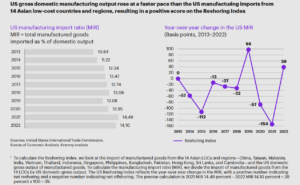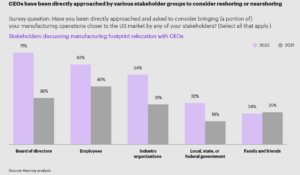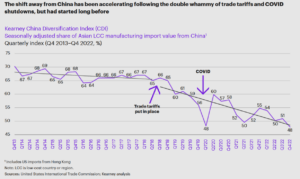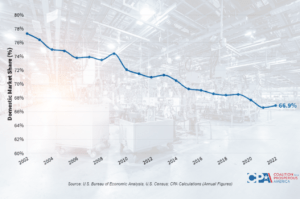Reshoring is one of those new dictionary words few of us know. To CPA members, it means production once sourced abroad is now sourced in the United States. It was always a lofty goal, given global corporate’s penchant for quarterly earnings, which is helped by low-cost labor in weak currency nations in Asia, and much weaker environmental standards that make it less onerous to run a manufacturing plant. But since the advent of Section 301 tariffs on China, and steel and aluminum tariffs on much of the world, the question has been whether production is coming home. The anti-tariff crowd wanted to prove that the ‘trade war tariffs’ were not helping to re-industrialize the U.S. While the pro-tariff crowd sought to prove that it indeed would.
Has it?
This month, Kearney, a global management consulting firm, revealed in a survey that 96% of CEOs are now evaluating reshoring their operations, or have done so already. That’s up 78% from 2021.
The report, titled “America is Ready for Reshoring. Are You?”, states that four years after Trump imposed nearly $400 billion in tariffs on China imports, the U.S. “finally seems to be heading towards a sustained reshoring movement.” The report quoted one unnamed CEO who said “reshoring will play a critical role in both the reimagining and the modernization of our supply chain.”
Like CPA, Kearney has their own Reshoring Index. It showed that in 2022, U.S. imports of manufactured goods from 14 Asian countries fell slightly to 14.1% from 14.5% in 2021. That discrepancy, they said, is due to reshoring.
Some companies have relocated sourcing from mainland China to SE Asia. This is the case with numerous goods – led by solar, lighting equipment such as LEDs, and furniture in Vietnam. The U.S. trade deficit with Vietnam, a country whose currency is worth pennies on the dollar, is now greater than that with Germany.
In the consumer electronics industry, companies such as Apple and Samsung have moved production out of China and expanded in India.
In apparel and textile, Kearney said they are noticing a similar trend of moving to SE Asia, citing lower wages, China’s Zero Covid policies from 2020-2022, and geopolitical risk with the U.S. and Europe. Many of the companies that have outsourced off the mainland, however, are Chinese companies.
Kearney said that some foreign companies that counted on the Generalized System of Preferences being renewed—which would allow them to benefit from tariff-free import from the majority of poor southeast Asian nations —have actually gone back to China as GSP’s renewal has proven elusive in Congress.

None of this sounds like reshoring, though. At best, this sounds more like what Janet Yellen and others refer to as “friend-shoring”. What about bringing production back to the U.S.?
The reshoring wheels are being greased, at least, and the activity is stemming from the C-suite, which is reading the tea leaves on political risk in doing business with China. Getting caught up in the Uyghur Forced Labor Prevention law, or Customs and Border Protection seizing goods due to forced labor concerns, and sanctions are all headwinds for American businesses there. That’s the stick. But the carrot has been things like the CHIPS Act and Inflation Reduction Act, CEOs acknowledged in the survey. Still, although critical, semiconductors and new “green tech” like solar panels and EVs cover only a slither of America’s manufacturing industries.

Tariffs started the move out of mainland China. Zero Covid exacerbated it.

A 2022 poll conducted by Retail Brew and The Harris Poll indicated that American consumers frequently seek out American-made products. Roughly half said they are willing to pay a 10% to 20% premium for domestically made goods.
CPA conducted a poll last April that showed 61% of American voters believe that increased imports have caused the U.S. to become dependent on China for goods that are critical to the U.S. economy and U.S. national security. Voters think tariffs should be used to protect U.S. industries and American workers. Only 16% disagreed. Some 73% of American voters surveyed support trade remedies against China to protect U.S. industries and American workers. Only 10% were opposed.
Much of the Kearney report is about sentiment and not about companies that have actually moved to sourcing locally.
What CPA’s Reshoring Index Shows
The CPA reshoring index was renamed the Domestic Market Share Index (DMSI) last year. It is updated quarterly.
That index finished 2022 at 67.8, up 1.3 percentage points from the third quarter, reflecting a slowdown in imports at the end of the year. The index ended the year at 66.9, an increase of 0.3 percentage points from the previous year, indicating that domestic producers increased share in the U.S. market in 2022.
The DMSI measures the share that U.S. domestic producers hold of the U.S. market for manufactured goods, so a reading of 66.9 means that foreign producers hold about one-third of the U.S. market for manufactured goods in the form of imports, and U.S. producers hold the rest, or roughly 67%.
The U.S. market for manufactured goods is worth about $7.2 trillion and is the world’s largest market. Since 2002, U.S. manufacturers have lost more than ten percentage points of home market share, falling from 77.3% in 2002 to 66.9% in 2022 despite all the talk of reshoring. This represents a setback for U.S. producers, who have traditionally been strongest in the home market.
 “Reshoring has begun in some industries, but it’s still pretty modest,” said CPA chief economist Jeff Ferry. “We need additional policies, focused specifically on restraining imports from many low-wage nations, to accelerate it.”
“Reshoring has begun in some industries, but it’s still pretty modest,” said CPA chief economist Jeff Ferry. “We need additional policies, focused specifically on restraining imports from many low-wage nations, to accelerate it.”
* * *
The Government Has Better Data
The International Trade Commission, an agency of the U.S. government tasked with analyzing trade flows, has a better view of reshoring post-2018. They published a report in March titled “Economic Impact of Section 232 and 301 Tariffs on U.S. Industries”. Section 232 is the steel and aluminum tariffs.
While the ITC did not use the term “reshoring”, it did find evidence of more production and more investment in 10 out of 9 sectors it looked at after tariffs were enacted.
Section 232 tariffs led to reduced imports of steel and aluminum by an estimated 24% and 31%, respectively, during the 2017-2021 period. U.S. production of steel and aluminum increased by 1.9% and 3.6% on average, respectively, during this period.
In dollar terms, U.S. production of steel and aluminum was $1.5 billion and $1.3 billion higher each year, respectively, than it would have been absent the tariffs, the ITC reported.
For Section 301 affected products, the ITC found that for all directly affected industries there was an overall increase in domestic production by 0.4% on average each year from 2018 to 2021. It also estimates a 13% decline in the value of U.S. imports from China.
For the 10 industries with the highest value of imports covered by Section 301 tariffs, the ITC model estimates that the value of U.S. production rose between 1.2% and 7.5% in 2021 as a result of Section 301 tariffs.
China Down, But Not Out
China still dominates, though its traditional manufacturing base has been greatly disrupted by the trade war. The country is also the leading producer of nearly all of the new technology goods the U.S. is counting on to build its post-fossil fuels economy – whether that be control of much of the solar supply chain, to its growing prowess in the EV battery market and in leading global wind turbine brands like Goldwind.
According to Kearney, there are some companies and some industries that are “pragmatically incapable” of considering reshoring or even friend-shoring.
Kearney cited chemical companies in particular, especially those that make base chemicals whether it’s Lysol or chemical compounds used to make medications. Environmental challenges in other markets, and cost structures (tax and labor) make it “extremely difficult” to bring base chemical manufacturing to the U.S., the report said.
Cost pressures are significant in the chemical industry, so much so that even though there was a shift out of China during the pandemic lockdowns, China is ramping back up fast and the base chemicals industry is back to relying on China once more, report authors wrote.
The U.S. trade deficit in manufactured goods rose 13% to $1.199 trillion last year, an all-time record.
Is ‘Reshoring’ Happening? New Reports, CPA Index Tries to Measure the Evidence
Reshoring is one of those new dictionary words few of us know. To CPA members, it means production once sourced abroad is now sourced in the United States. It was always a lofty goal, given global corporate’s penchant for quarterly earnings, which is helped by low-cost labor in weak currency nations in Asia, and much weaker environmental standards that make it less onerous to run a manufacturing plant. But since the advent of Section 301 tariffs on China, and steel and aluminum tariffs on much of the world, the question has been whether production is coming home. The anti-tariff crowd wanted to prove that the ‘trade war tariffs’ were not helping to re-industrialize the U.S. While the pro-tariff crowd sought to prove that it indeed would.
Has it?
This month, Kearney, a global management consulting firm, revealed in a survey that 96% of CEOs are now evaluating reshoring their operations, or have done so already. That’s up 78% from 2021.
The report, titled “America is Ready for Reshoring. Are You?”, states that four years after Trump imposed nearly $400 billion in tariffs on China imports, the U.S. “finally seems to be heading towards a sustained reshoring movement.” The report quoted one unnamed CEO who said “reshoring will play a critical role in both the reimagining and the modernization of our supply chain.”
Like CPA, Kearney has their own Reshoring Index. It showed that in 2022, U.S. imports of manufactured goods from 14 Asian countries fell slightly to 14.1% from 14.5% in 2021. That discrepancy, they said, is due to reshoring.
Some companies have relocated sourcing from mainland China to SE Asia. This is the case with numerous goods – led by solar, lighting equipment such as LEDs, and furniture in Vietnam. The U.S. trade deficit with Vietnam, a country whose currency is worth pennies on the dollar, is now greater than that with Germany.
In the consumer electronics industry, companies such as Apple and Samsung have moved production out of China and expanded in India.
In apparel and textile, Kearney said they are noticing a similar trend of moving to SE Asia, citing lower wages, China’s Zero Covid policies from 2020-2022, and geopolitical risk with the U.S. and Europe. Many of the companies that have outsourced off the mainland, however, are Chinese companies.
Kearney said that some foreign companies that counted on the Generalized System of Preferences being renewed—which would allow them to benefit from tariff-free import from the majority of poor southeast Asian nations —have actually gone back to China as GSP’s renewal has proven elusive in Congress.
None of this sounds like reshoring, though. At best, this sounds more like what Janet Yellen and others refer to as “friend-shoring”. What about bringing production back to the U.S.?
Tariffs started the move out of mainland China. Zero Covid exacerbated it.
A 2022 poll conducted by Retail Brew and The Harris Poll indicated that American consumers frequently seek out American-made products. Roughly half said they are willing to pay a 10% to 20% premium for domestically made goods.
CPA conducted a poll last April that showed 61% of American voters believe that increased imports have caused the U.S. to become dependent on China for goods that are critical to the U.S. economy and U.S. national security. Voters think tariffs should be used to protect U.S. industries and American workers. Only 16% disagreed. Some 73% of American voters surveyed support trade remedies against China to protect U.S. industries and American workers. Only 10% were opposed.
Much of the Kearney report is about sentiment and not about companies that have actually moved to sourcing locally.
What CPA’s Reshoring Index Shows
The CPA reshoring index was renamed the Domestic Market Share Index (DMSI) last year. It is updated quarterly.
That index finished 2022 at 67.8, up 1.3 percentage points from the third quarter, reflecting a slowdown in imports at the end of the year. The index ended the year at 66.9, an increase of 0.3 percentage points from the previous year, indicating that domestic producers increased share in the U.S. market in 2022.
The DMSI measures the share that U.S. domestic producers hold of the U.S. market for manufactured goods, so a reading of 66.9 means that foreign producers hold about one-third of the U.S. market for manufactured goods in the form of imports, and U.S. producers hold the rest, or roughly 67%.
The U.S. market for manufactured goods is worth about $7.2 trillion and is the world’s largest market. Since 2002, U.S. manufacturers have lost more than ten percentage points of home market share, falling from 77.3% in 2002 to 66.9% in 2022 despite all the talk of reshoring. This represents a setback for U.S. producers, who have traditionally been strongest in the home market.
* * *
The Government Has Better Data
The International Trade Commission, an agency of the U.S. government tasked with analyzing trade flows, has a better view of reshoring post-2018. They published a report in March titled “Economic Impact of Section 232 and 301 Tariffs on U.S. Industries”. Section 232 is the steel and aluminum tariffs.
While the ITC did not use the term “reshoring”, it did find evidence of more production and more investment in 10 out of 9 sectors it looked at after tariffs were enacted.
Section 232 tariffs led to reduced imports of steel and aluminum by an estimated 24% and 31%, respectively, during the 2017-2021 period. U.S. production of steel and aluminum increased by 1.9% and 3.6% on average, respectively, during this period.
In dollar terms, U.S. production of steel and aluminum was $1.5 billion and $1.3 billion higher each year, respectively, than it would have been absent the tariffs, the ITC reported.
For Section 301 affected products, the ITC found that for all directly affected industries there was an overall increase in domestic production by 0.4% on average each year from 2018 to 2021. It also estimates a 13% decline in the value of U.S. imports from China.
For the 10 industries with the highest value of imports covered by Section 301 tariffs, the ITC model estimates that the value of U.S. production rose between 1.2% and 7.5% in 2021 as a result of Section 301 tariffs.
China Down, But Not Out
China still dominates, though its traditional manufacturing base has been greatly disrupted by the trade war. The country is also the leading producer of nearly all of the new technology goods the U.S. is counting on to build its post-fossil fuels economy – whether that be control of much of the solar supply chain, to its growing prowess in the EV battery market and in leading global wind turbine brands like Goldwind.
According to Kearney, there are some companies and some industries that are “pragmatically incapable” of considering reshoring or even friend-shoring.
Kearney cited chemical companies in particular, especially those that make base chemicals whether it’s Lysol or chemical compounds used to make medications. Environmental challenges in other markets, and cost structures (tax and labor) make it “extremely difficult” to bring base chemical manufacturing to the U.S., the report said.
Cost pressures are significant in the chemical industry, so much so that even though there was a shift out of China during the pandemic lockdowns, China is ramping back up fast and the base chemicals industry is back to relying on China once more, report authors wrote.
The U.S. trade deficit in manufactured goods rose 13% to $1.199 trillion last year, an all-time record.
MADE IN AMERICA.
CPA is the leading national, bipartisan organization exclusively representing domestic producers and workers across many industries and sectors of the U.S. economy.
TRENDING
CPA Sends Letter To Senate Leaders Schumer and McConnell Opposing Advancement of Recent USITC Nominations
CPA: Liberty Steel Closures Highlight Urgent Need to Address Mexico’s Violations and Steel Import Surge
CPA Applauds Chairman Jason Smith’s Reappointment to Lead House Ways and Means Committee
Senator Blackburn and Ossoff’s De Minimis Bill is Seriously Flawed
JQI Dips Due to Declining Wages in Several Sectors as November Jobs Total Bounces Back from Low October Level
The latest CPA news and updates, delivered every Friday.
WATCH: WE ARE CPA
Get the latest in CPA news, industry analysis, opinion, and updates from Team CPA.
CHECK OUT THE NEWSROOM ➔